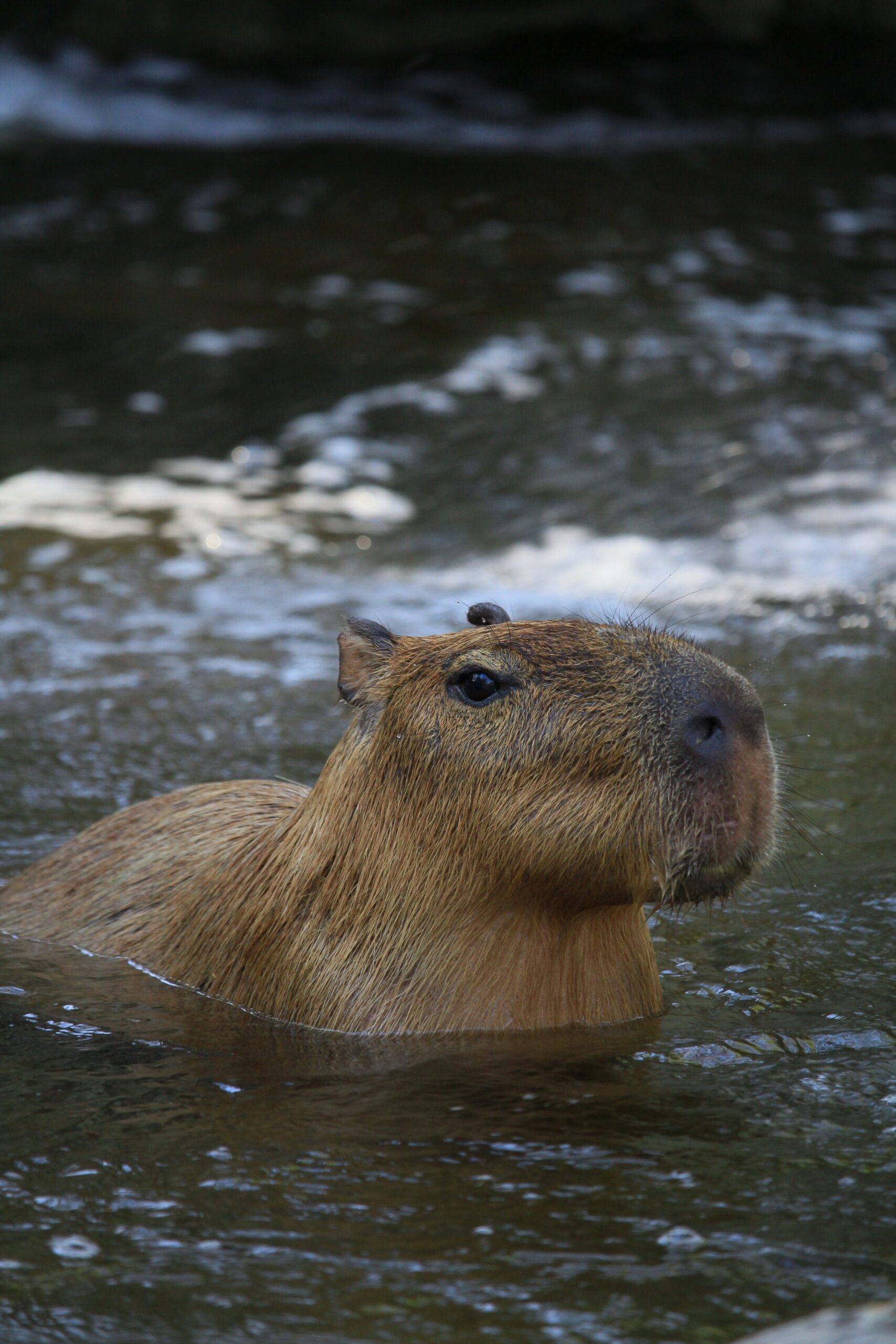Imagine coming across a creature with a name as unique as the capybara. You can’t help but wonder how this animal’s size compares to that of a human. In just one paragraph, we’ll explore the intriguing question of how the dimensions of a capybara measure up against ours. Get ready to be amazed by the astonishing facts about the size of these fascinating creatures.

Physical characteristics of a capybara
Size
Capybaras are the largest rodents in the world and can reach an impressive size. On average, they are approximately 3 to 4.5 feet long from head to tail, making them quite comparable to a medium-sized dog. They have a stout and robust body, with a stocky build and short legs. Capybaras may weigh anywhere between 77 to 143 pounds, depending on their age, sex, and overall health.
Weight
The weight of a capybara can vary significantly, but it is generally influenced by factors such as age, gender, and genetic variation. Adult male capybaras tend to be larger and heavier than females. The average weight of a fully-grown capybara ranges from 77 to 143 pounds, although there have been exceptional cases where individuals have exceeded these limits.
Body structure
Capybaras have a unique body structure that is adapted to their semi-aquatic lifestyle. Their body is elongated and has a barrel-shaped appearance, with a large head and small, rounded ears. Capybaras also possess a long, robust snout, which aids in their foraging activities. Their limbs are relatively short but powerful, enabling them to navigate through various terrains, including water. With webbed feet, capybaras are highly adapted for swimming and moving through marshy environments.
Fur and coloration
Capybaras have a dense, short coat of fur that aids in their water-resistant properties. Their fur can vary in color, ranging from a reddish-brown or grayish-brown hue, depending on the individual and its surrounding environment. The fur is typically coarse and helps protect them from potential predators and harsh weather conditions. This adaptable coloration allows capybaras to blend in with their surroundings and provides effective camouflage in their natural habitat.
Size comparison between a capybara and a human
Height
When it comes to height, capybaras are generally comparable to an average-sized dog. On all fours, their shoulder height can range between 1 to 2 feet, depending on the individual. However, if they stand on their hind legs, capybaras can reach up to 2.5 to 3 feet tall, making them taller than the average human child or even some adults.
Length
Capybaras are typically measured from their snout to their tail, which can result in varying lengths. On average, capybaras can measure between 3 to 4.5 feet in length. This length is inclusive of their robust bodies and elongated tails, which serve as essential balance and communication tools for these impressive creatures.
Weight
In terms of weight, adult capybaras are considerably larger than most humans. While the average adult capybara weighs around 77 to 143 pounds, humans typically range in weight. However, capybaras can outweigh many humans, especially children or petite individuals.
Proportions
Capybaras have slightly different proportions compared to humans. Their bodies are typically longer and more cylindrical, which gives them a more compact appearance. In contrast, humans have a more upright posture and an elongated torso in relation to their limbs. Despite these variations, capybaras and humans share some anatomical similarities, such as a skeletal structure, albeit with different dimensions and proportions.

Size variations among capybara individuals
Sexual dimorphism
There is a noticeable size difference between male and female capybaras, with males typically being larger and heavier. Adult male capybaras can weigh up to 143 pounds, while females average around 77 to 100 pounds. This sexual dimorphism is a common characteristic in many animal species and can serve various purposes, such as competition for mates or defense against predators.
Age-related differences
Size disparities among capybaras can also be observed when considering their age. Like many mammals, capybaras experience growth spurts during their early years, with individuals reaching their full size and weight by around two to three years of age. Young capybaras are significantly smaller and lighter than their adult counterparts, reflecting their ongoing development. As they age, capybaras continue to mature physically and demonstrate subtle changes in size and weight.
Capybara adaptations related to their size
Aquatic lifestyle
Capybaras’ large size is closely associated with their semi-aquatic lifestyle. Their robust bodies and webbed feet are ideal adaptations for swimming and maneuvering in aquatic environments. Capybaras spend a significant amount of time in the water, taking advantage of their size to access abundant food sources, escape predators, and regulate their body temperature.
Social behavior
Capybaras are highly social animals, living in groups known as herds. Their size plays a significant role in their social dynamics, as larger individuals tend to exhibit dominance within the group hierarchy. Being larger can provide advantages during conflicts, mating rituals, and securing resources. The size of capybaras allows them to assert their social authority and maintain a stable hierarchy within their communities.
Thermoregulation
Capybaras inhabit regions with diverse climates, from tropical wetlands to cooler grasslands. Their large bodies enable them to regulate their internal body temperature more effectively. On hotter days, capybaras can rely on their size and surface area to dissipate excess heat through their skin and promote cooling. Conversely, their size also helps retain body heat in colder environments, ensuring their survival in variable climates.

Comparison of capybara size with other animals
Largest rodent
Capybaras unquestionably hold the title for the largest rodents in the world. While they are often compared to dogs or small pigs in terms of size, capybaras far surpass all other rodent species, both in terms of weight and overall dimensions. This unique distinction showcases the remarkable size and evolutionary adaptations of these fascinating creatures.
Capybara vs. other mammals
When it comes to comparing capybaras to other mammals, their size is still quite notable. While they may not be the largest mammals overall, capybaras surpass the average size of several commonly encountered mammals, such as raccoons, beavers, or domestic cats. Their large size contributes to their distinct presence and often captures the attention of humans who encounter them.
Capybara vs. other rodents
In the rodent world, capybaras stand out as giants among their smaller relatives. Most rodents, such as rats, mice, or squirrels, are significantly smaller than capybaras. This size difference stems from the diversity and adaptability of rodents as a whole. However, capybaras showcase unparalleled growth potential within the rodent family, displaying the incredible variety of shapes and sizes found within this taxonomic group.
Human fascination with the capybara’s size
Novelty factor
Capybaras’ impressive size has captured the fascination of humans worldwide. As creatures that defy conventional expectations for rodents, their large stature evokes a sense of awe and wonder in those who encounter them. The novelty factor associated with their size makes capybaras highly appealing and intriguing to both animal enthusiasts and the general public alike.
Internet popularity
In recent years, capybaras have gained significant popularity on the internet. Social media platforms have become inundated with adorable and amusing pictures and videos of capybaras, often showcasing their size in various contexts. The internet’s collective fascination with these gentle giants has led to an increase in their visibility and a greater appreciation for their unique characteristics, extending beyond their size alone.
Cultural and symbolic significance of capybara’s size
In indigenous South American cultures
In many indigenous South American cultures, the capybara holds symbolic importance, sometimes associated with their size. Among several indigenous communities, the capybara is revered as a sacred animal, representing wisdom, abundance, and communal harmony. Its size reflects the abundance of resources available in its habitat, making it an essential figure in various cultural practices and rituals.
Portrayals in folklore and mythology
Capybaras often find their way into folklore and mythology across different cultures. Tales and legends frequently highlight the capybara’s size and extraordinary qualities, portraying it as a powerful and awe-inspiring being. These narratives often emphasize the capybara’s close relationship with water, linking its large size to its ability to navigate and thrive in aquatic environments.
Capybara as a representation of abundance
Due to their large size, capybaras are sometimes depicted as symbols of abundance and prosperity. Their association with bountiful resources is mirrored in various art forms, traditional crafts, and even culinary traditions. The capybara’s size carries cultural connotations that go beyond mere physicality, imbuing it with broader significance and meaning within its cultural contexts.
Interaction between humans and capybaras
Keeping capybara as a pet
In some regions, it is legal to keep capybaras as pets, although it requires specific permits and adherence to regulations regarding their care and welfare. Certain individuals are drawn to capybaras’ size and gentle demeanor, as they can make unique and unconventional companions. However, the decision to keep a capybara as a pet should be made thoughtfully, considering their specialized needs, the legality of ownership, and one’s ability to provide a suitable environment for their well-being.
Tourism and wildlife viewing
Capybaras have become popular attractions in wildlife reserves, nature parks, and eco-tourism destinations. Tourists and nature enthusiasts seek opportunities to observe capybaras in their natural habitats, appreciating their size and social dynamics. Establishments offering wildlife viewing experiences aim to provide educational encounters while ensuring the conservation and welfare of capybaras and their habitats.
Conservation efforts
Given their size and unique ecological niche, capybaras play an essential role in the ecosystems they inhabit. Conservation efforts are critical to maintaining their populations and protecting their habitats. Conservation organizations work towards preserving wetland areas, ensuring sustainable management practices, and promoting awareness about the importance of capybaras in maintaining the overall balance of their respective ecosystems.
Ethical considerations regarding human-capybara interactions
Animal welfare concerns
Interactions between humans and capybaras, whether as pets or in wildlife tourism, must be approached with careful consideration for the animals’ welfare. Capybaras are complex beings with specific biological and behavioral needs. Ensuring their physical and psychological well-being is paramount, emphasizing the provision of proper diet, space, socialization, and veterinary care.
Sustainable management practices
For capybaras living in the wild, sustainable management practices are crucial in mitigating potential human-wildlife conflicts and ensuring their continued survival. Balancing the needs and interests of local communities, agriculture, and capybara conservation is essential for the long-term welfare of both humans and capybaras. This encompasses strategies such as habitat preservation, responsible land use planning, and effective legislation to protect both species’ interests.
Conclusion
The size of capybaras sets them apart in the animal kingdom, making them a remarkable and intriguing species. From their physical characteristics to their societal significance, capybaras’ large stature captivates humans and fosters a connection between the two species. However, it is crucial that this fascination is accompanied by responsible and ethical practices, ensuring the well-being and conservation of capybaras for generations to come.



